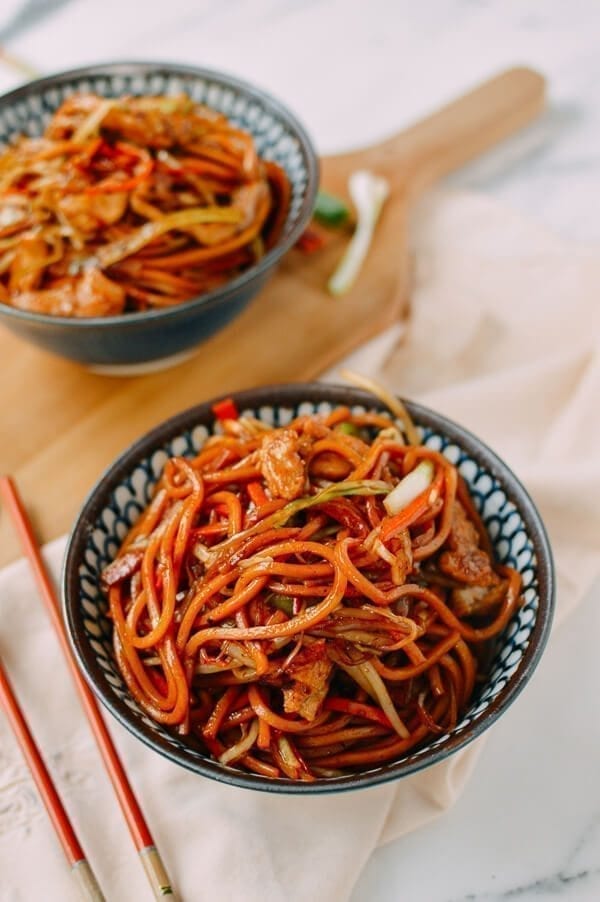Chicken Lo Mein is a classic takeout dish we’ve all probably enjoyed. We find, however, that it’s getting harder than ever to get a good lo mein these days! Hence the need for this recipe.
Note:
This post was originally published on November 19, 2019. We have since updated it with clearer instructions, nutrition info, and metric measurements. The recipe itself remains the same. Enjoy!
A Personal Takeout Favorite
Growing up, having Chinese takeout for dinner was an uncommon occurrence. Usually, my mom or dad would prepare dinner.
On the rare occasion that both my parents were too tired or busy to cook, however, we would order from No. 1 Chinese Restaurant. An apt name, because that particular place made some of the best takeout food I’ve ever had.
While you may think the dishes we ordered from the standard takeout menu were similar to what we were eating every night for dinner, nothing could really be further from the truth. Dishes like beef and broccoli, Singapore May Funand chicken lo mein were a rare treat.
When it came to Chinese takeout, I ALWAYS requested chicken lo mein. It’s still my go-to when I order out these days, but too often, the noodles lack taste / flavor and are soggy or overly greasy.
Which is why I decided to make it myself, with spectacular (if I may say so) results in just 30 minutes.
This is the chicken lo mein that I crave and remember from my childhood—from that hole-in-the-wall joint called No. 1!
If you’re a lo mein fan, give this recipe a try! The key to the deep color of these noodles is dark soy saucewhich you can find at any Chinese grocery store.
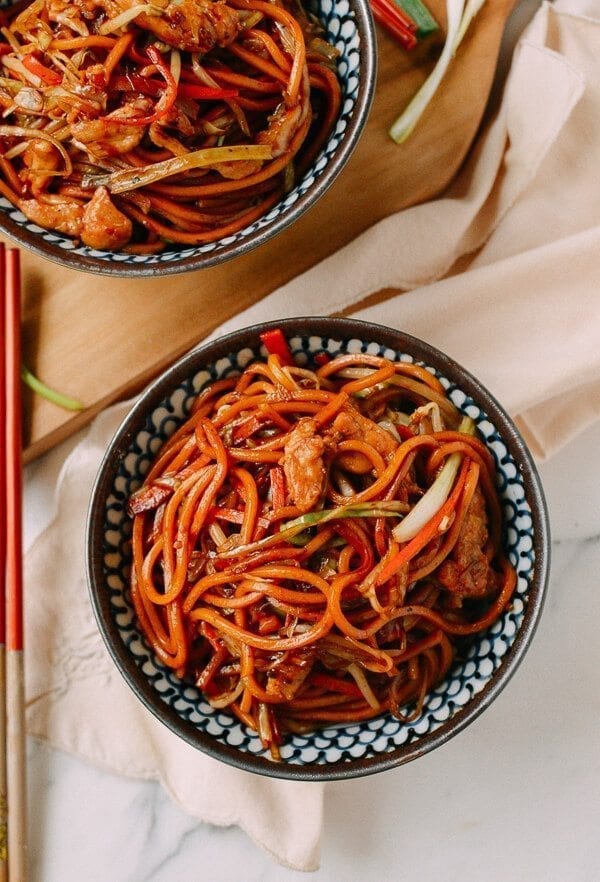
Best Noodles for Lo Mein
There are two main noodle options for making lo mein: uncooked lo mein noodles, and cooked lo mein noodles. Both are egg noodles, so they should be yellow in color (note, they may also be labeled “Hokkien Noodles”).
The main difference is that the uncooked noodles must be pre-boiled before stir-frying, while the cooked noodles are ready to go straight into the wok.
You may also see the term “oil noodle” on a package of fresh noodles, with the Chinese characters: 油面. This is also the correct noodle to use! They are often oiled before packaging, to keep the noodles from sticking together.
If using uncooked lo mein noodles, be sure to follow the directions on the package. Boil them until they are just cooked (al dente), dump them into a colandergive them a quick rinse in warm water, and drain thoroughly.
If you find cooked lo mein noodles (readily available today from many Chinese grocery stores)give them a quick rinse in hot water to break up the block of noodles. That’s all the prep needed!
We’ve found that people often confuse lo mein with chow mywhich simply means, “stir-fried noodles.”
Chow mein (炒面 – chǎomiàn) simply means “stir-fried noodles.” When we think of chow mywe think of Hong Kong Style pan-fried noodles like in our Vegetable Chow Meinthough here in the U.S., many people do tend to think of a softer noodle like lo mein. Because the term “chow mein” has been used so liberally in the West, things can get confusing.
So if you’re still confused about what type of noodle to use, check out our entire post on the how to prepare different types of noodles for lo mein!
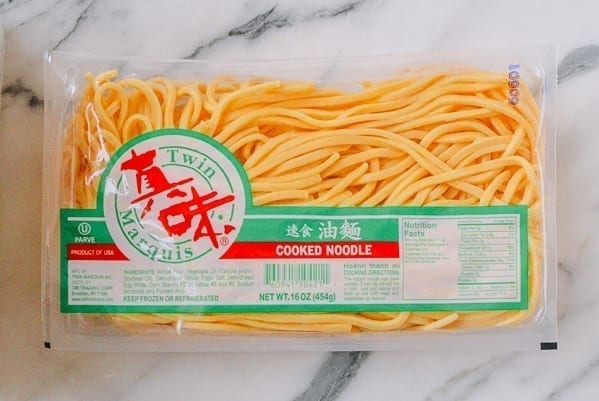
Note!
My preferred veggies for this dish include: carrots, cabbage, bean sprouts, and scallions. This is the combination I remember from my favorite lo mein growing up. I think it offers the perfect mix of textures and flavorsand adding freshness and crunch without overpowering the dish.
If you prefer, you can also add other common vegetables like red bell pepper, mushrooms, and snow peas.
Chicken Lo Mein Recipe Instructions
In a medium bowl, combine the chicken with 2 teaspoons each of cornstarch, water, and oil. I prefer using boneless skinless chicken thighs in this recipe, but you can also use boneless skinless chicken breast if you prefer.
In a wok over high heat, add 2 tablespoons oil, and sear the chicken for a couple minutes until browned. Remove from the wok and set aside.
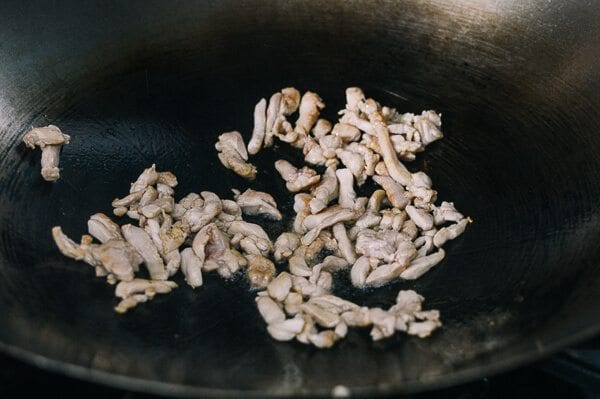
Add another couple tablespoons of oil to the wokand add the garlic. After 10 seconds, add the cabbage and carrots. Stir-fry the vegetables on high heat for a minute and add the wine in a circle around the perimeter of the wok.
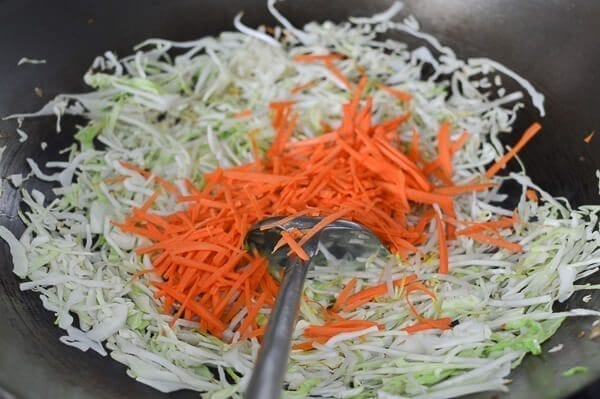
Add the noodles and chicken back to the wok and mix well from the bottom up for about 30 seconds. Lift the noodles with your wok spatula and shake them to toss them and distribute the vegetables, chicken, and noodles.
If the noodles aren’t coming apart, add about 1/4 cup water (or chicken broth) to the noodles to loosen them up a bit.
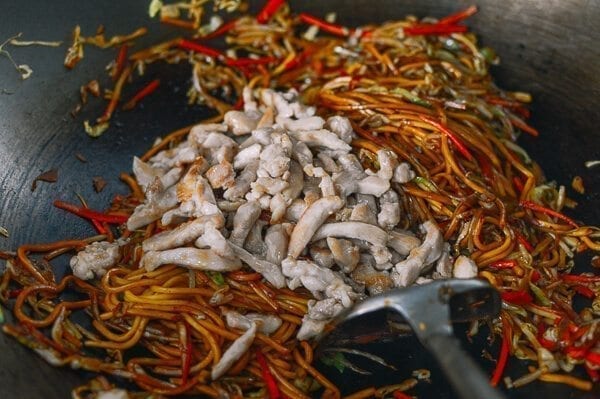
Then reduce the heat to medium and cover the wok for one minute. Remove the cover and add the soy sauce, dark soy sauce, sesame oil, salt, and sugar. (You can also mix up this lo mein sauce in advance.)
Stir-fry for 30 seconds, and add the final ingredients: the bean sprouts and scallions (green onions).
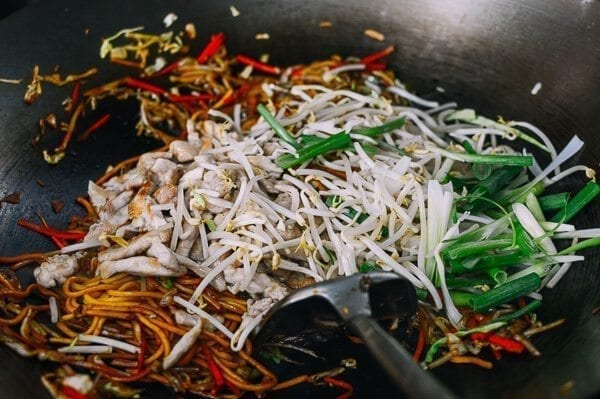
Stir-fry for one more minute…
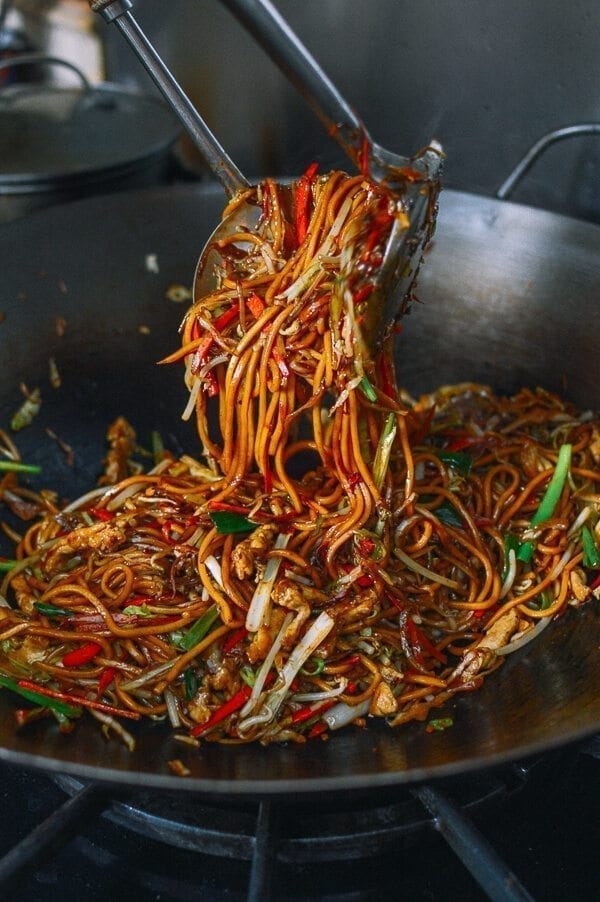
And serve your home-cooked Chicken Lo Mein!
For more lo mein recipes, check out our beef lo mein, vegetable lo meinand shrimp lo mein.
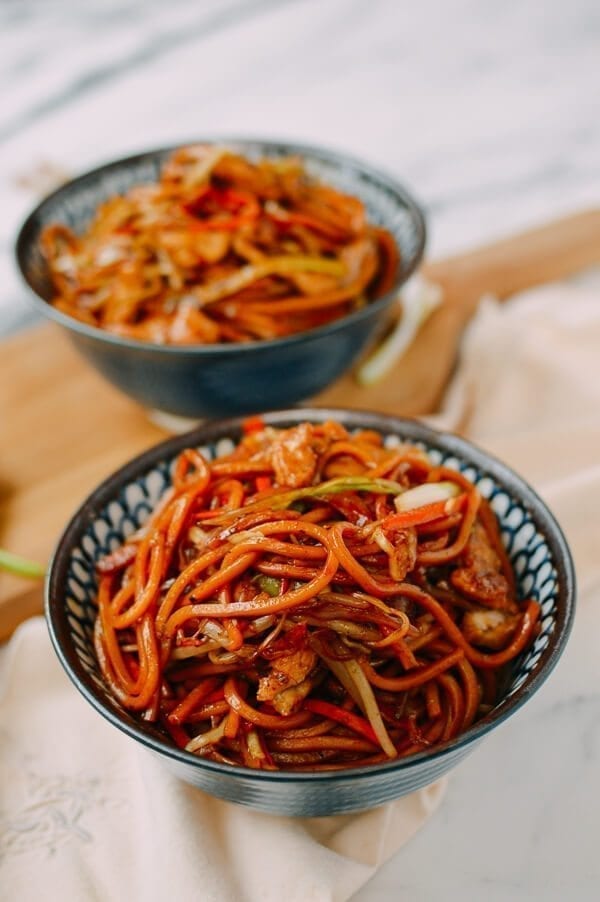
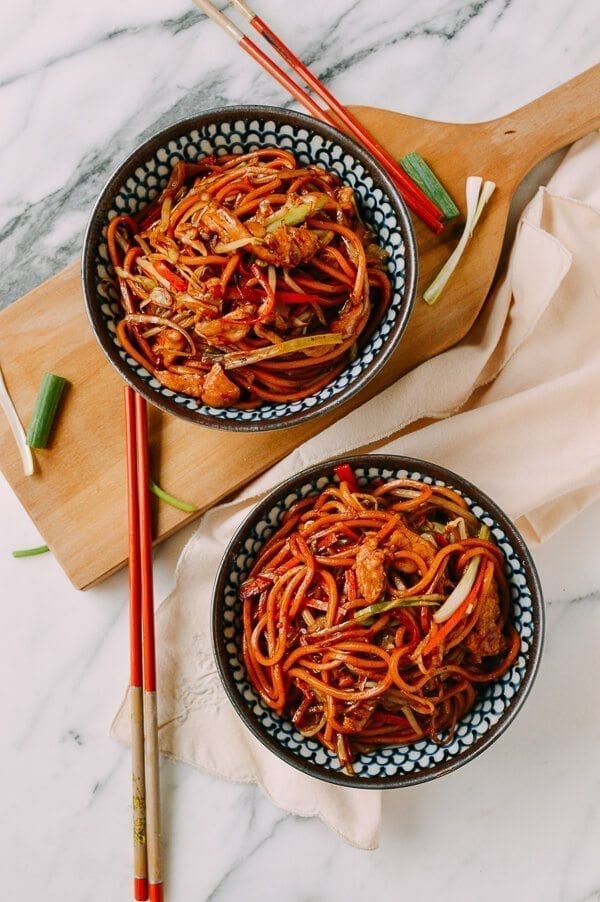
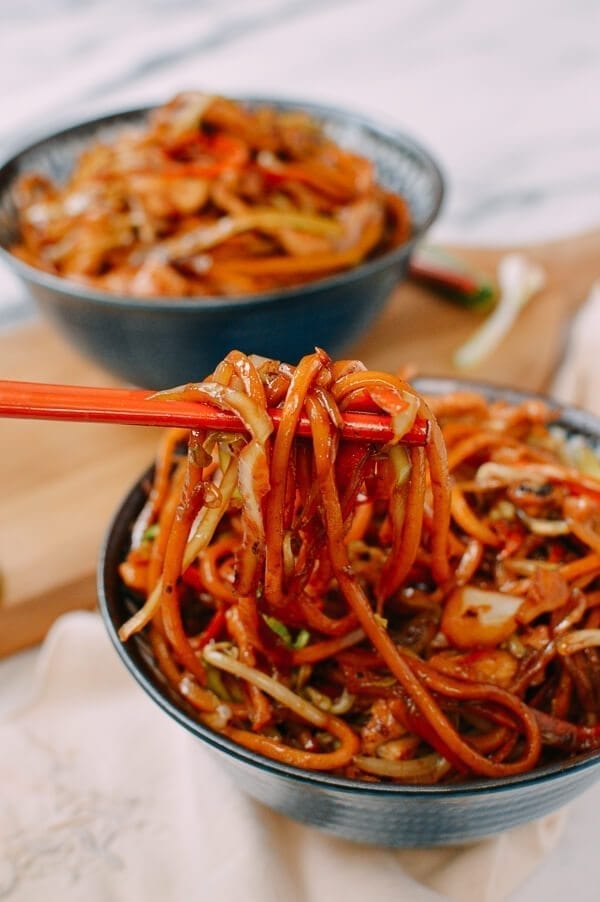
Note: Nutrition information in recipe card below is for 1/6 of the recipe (1 serving). Total time to prepare the recipe does not include time to boil noodles. If using uncooked lo mein, add another 10-15 mins to your prep time. Store any leftovers in an airtight container. The best way to reheat is in the microwave.
Restaurant-Style Chicken Lo Mein
This chicken lo mein recipe is surprisingly easy to make at home, and it actually tastes a lot better than what you can get at most takeout restaurants.
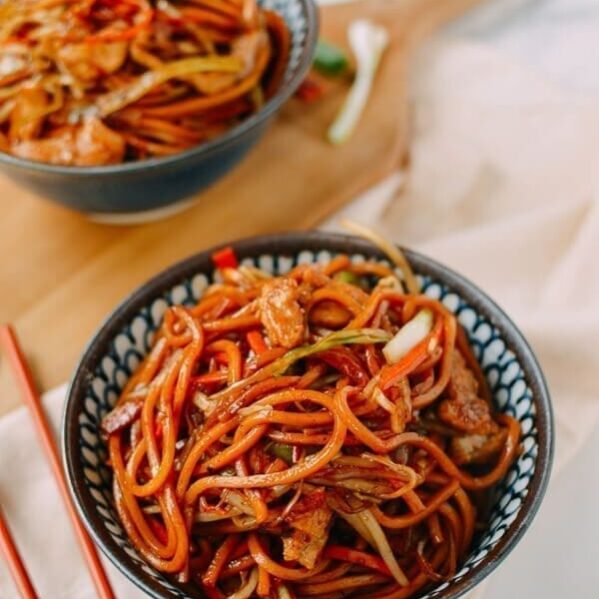
serves: 6
Prep: 20 minutes
Cook: 10 minutes
Total: 30 minutes
Instructions
-
In a medium bowl, combine the chicken with 2 teaspoons each of cornstarch, water, and oil. In a wok over high heat, add 2 tablespoons oil, and sear the chicken for a couple minutes until browned. Remove from the wok, and set aside.
-
Add another couple tablespoons of oil to the wok, and add the garlic. After 10 seconds, add the cabbage and carrots. Stir-fry on high heat for a minute and add the wine in a circle around the perimeter of the wok.
-
Add the noodles and chicken back to the wok and mix well from the bottom up for about 30 seconds. If the noodles aren’t coming apart, add about 1/4 cup water to the noodles to loosen them up a bit.
-
Then reduce the heat to medium and cover the wok for one minute. Remove the cover and add the soy sauce, dark soy sauce, sesame oil, salt, and sugar. Stir-fry for 30 seconds, and add the bean sprouts and scallions. Stir-fry for one more minute and serve.
nutrition facts
Calories: 306kcal (15%) Carbohydrates: 42g (14%) Protein: 13g (26%) Fat: 5g (8%) Saturated Fat: 1g (5%) Cholesterol: 58mg (19%) Sodium: 502mg (21%) Potassium: 343mg (10%) Fiber: 3g (12%) Sugar: 4g (4%) Vitamin A: 3510IU (70%) Vitamin C: 23.8mg (29%) Calcium: 45mg (5%) Iron: 1.6mg (9%)
Note: This recipe was originally published on our blog on August 22, 2016. We have updated it with nutrition information, metric measurements, and clearer instructions. The recipe remains the same. Enjoy!

